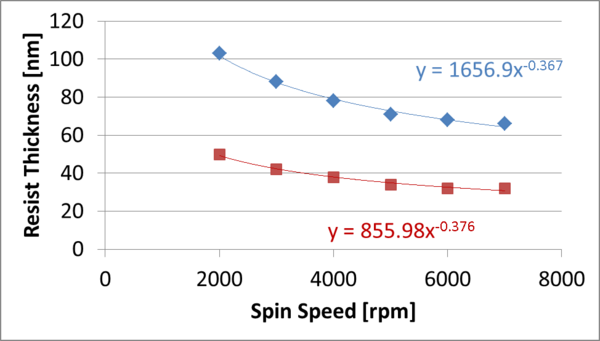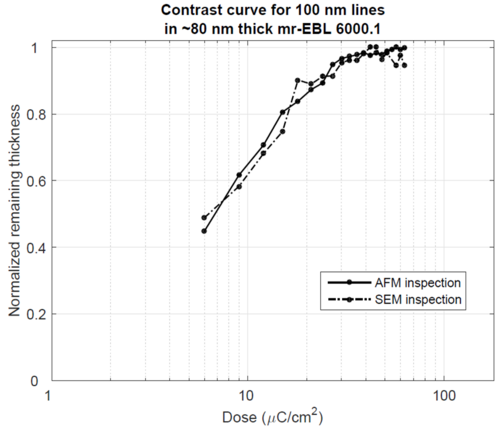Specific Process Knowledge/Lithography/mrEBL6000: Difference between revisions
No edit summary |
No edit summary |
||
| Line 34: | Line 34: | ||
mrEBL6000 works as a negative e-beam resist but is also UV sensitive, why resist and coated wafers should be kept in yellow rooms only. When carrying the wafers to the e-beam writer, use a black or blue box for protection. While mounting the wafers in the e-beam cassettes, you can turn off the white light in the e-beam room and turn on the yellow light which is located above the pre-aligner setup. | mrEBL6000 works as a negative e-beam resist but is also UV sensitive, why resist and coated wafers should be kept in yellow rooms only. When carrying the wafers to the e-beam writer, use a black or blue box for protection. While mounting the wafers in the e-beam cassettes, you can turn off the white light in the e-beam room and turn on the yellow light which is located above the pre-aligner setup. | ||
mrEBL6000 is a chemically amplified resists, i.e. immediately after e-beam exposure, the wafers require a post-exposure bake. If no post-exposure bake is performed, the resist is not crosslinked and will most likely dissolve during development. | |||
<br> | <br> | ||
Revision as of 12:14, 12 July 2016
| Resist | Polarity | Manufacturer | Comments | Technical reports | Developer | Rinse | Remover | Process flows (in docx-format) |
| mr EBL 6000.1 | Positive | MicroResist | Standard negative resist | mrEBL6000 processing Guidelines.pdf | mr DEV | IPA | mr REM | Process_Flow_mrEBL6000.docx |
mrEBL6000 works as a negative e-beam resist but is also UV sensitive, why resist and coated wafers should be kept in yellow rooms only. When carrying the wafers to the e-beam writer, use a black or blue box for protection. While mounting the wafers in the e-beam cassettes, you can turn off the white light in the e-beam room and turn on the yellow light which is located above the pre-aligner setup.
mrEBL6000 is a chemically amplified resists, i.e. immediately after e-beam exposure, the wafers require a post-exposure bake. If no post-exposure bake is performed, the resist is not crosslinked and will most likely dissolve during development.
3 week project on mrEBL6000 by William Tiddi
mrEBL6000 was studied April 2015 by William Tiddi; the report can be found here.
Spin Curve

The thickness is measured on VASE Ellipsometer using a simple Cauchy model for a transparent polymer on Si. The measurements are performed at one incidence angle (70 degrees) only.
9 points on each 4" wafer has been measured; the standard deviation thus representing the homogeinity of the film on the 4" wafers.
| MicroResist mr EBL 6000. Spin coated on Spin Coater: Manual LabSpin A-5, WILTID, 2015. Softbake 3 min @ 110 degC. | ||
|---|---|---|
| Spin Speed [rpm] | Thickness [nm] | St Dev |
| 2000 | 103 | 0.5 |
| 3000 | 88 | 0.4 |
| 4000 | 78 | 0.4 |
| 5000 | 71 | 0.7 |
| 6000 | 68 | 0.5 |
| 7000 | 66 | 0.6 |
| MicroResist mr EBL 6000 diluted 1:1 in anisole. Spin coated on Spin Coater: Manual LabSpin A-5, WILTID, 2015. Softbake 3 min @ 110 degC. | ||
|---|---|---|
| Spin Speed [rpm] | Thickness [nm] | St Dev |
| 2000 | 50 | 0.2 |
| 3000 | 42 | 0.5 |
| 4000 | 38 | 0.5 |
| 5000 | 34 | 0.3 |
| 6000 | 32 | 0.3 |
| 7000 | 32 | 0.3 |
Contrast Curve
The contrast curve is measured on lines 100 nm in width, exposed with doses in the range of 6-63 µC/cm2. After exposure, the sample has been post-exposure baked 5 min @ 110 degree C. Development is performed with mr-DEV 600 in 40s followed by an IPA rinse 60s. These measurements are performed by WILTID April 2015.


